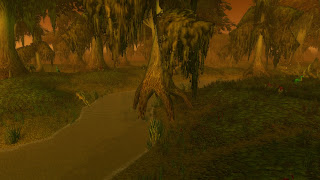 |
| Midday in the Wetlands |
I'm on my way towards earning a Bachelor's degree in Environmental Studies - specifically Geography, and in the fall term I took a course titled "Wetlands". It's one of the required 4th year courses and it was a large step up from other courses I'd previously taken. This course teaches the basics AND the advanced knowledge of wetlands and their inner workings, so it is a lot to absorb in four months. What I'm going to try to do is give you a crash course on things I learned that translated into seeing WoW environments in a more appreciative light.
Every country has their own Wetland Classification System, even provinces and states can have their own as well. For example, Canada has the Canadian Wetland Classification System and within Ontario we use the Southern Ontario Wetland Evaluation System (SOWES) to determine different wetland values. A wetland in Canada is not the same as one in the United States. More specifically a wetland in the Hudson Bay Lowlands is not the same as the Everglades in Florida. All wetlands are different, no matter where they are.
There are many types of wetlands, and wetlands themselves are split into subsections of peatlands and mineral wetlands. These two categories are again split up into more classes. Bogs, fens and marshes are peatlands, while swamps are considered mineral wetlands. Peatlands are wetlands that build up what is known as 'peat'. This peat is formed from decaying organic matter (leaves, animals, wood, plants), and decays slow enough that it builds up over time (a long time - think 100s of years). A mineral wetland has minimal to no peat build up, but still follows the general rule of being wet for most of the year - a swamp for example has water flowing through it, and is completely saturated for most of the year giving organic matter not enough access to oxygen to decay.
 |
| Huuuuuge... swaths of cattails. Spongy Lake, Ontario |
In addition to having unique ecosystems and groundwater patterns, there are plants that are indicative of what type of wetland you're looking at, and that show you what is going on in the soil. For example, cattails are an indication that there is some sort of disturbance going on. Usually that means that there is an influx of Nitrogen or Phosphorous which is commonly seen around agriculture areas when the fertilizer runs off into another area - think about where you see cattails, you also have a multitude of the plant around roadways. There will be a swath of cattails around where the disturbance is occurring. The presence of plants along the water channels can also be an indication of 'terrestrialization', a process that happens in wetlands when plants begin to infill areas that were previously open water.
Why is this important? Peatlands (particularly bogs, certain types of fens and marshes) are nutrient poor - in layman's terms this means that the environment in wetlands is not good for plants that need a lot of nutrients to survive and that the plants IN a wetland are adapted to living in an environment where they don't always get the nutrients they need. Cattails need more nutrients than what is supplied so when you see them, you know something else is going on.
The Wetlands zone in World of Warcraft is strikingly similar to a real world wetland. Did you know that cranberries require a specific acidic (high ph) environment to grow and that the plant has seeds that can float when the water rises? Cranberries only grow in a wetland environment, and during Pilgrim's Bounty you can (on Alliance side) pick up Tangy Wetland Cranberries. I did some sleuthing and found that the Horde pick up Tangy Southfury Cranberries. Not wetland cranberries, but I'll assume these particular cranberries grow along the Southfury River.
 |
| Look closely, you can see the cattails. |
The Wetlands zone is no exception. This sudden influx of water from Loch Modan looks like it caused some serious damage. There are cattails all along the channels of water, indicating a massive nutrient influx. Trees are knocked over or drowning in water that is now much too deep. The environment is not equipped to deal with that kind of disturbance.
The really cool part of the zone is that it seems to be a mishmash of different types of wetlands. It's got trees, so that could be a swamp or marsh. There's standing water that appears to be there year-round so that's swamp or marsh again. Near the edges, close to the sea the proper name would be a tidal wetland. There also seems to be some boggy parts too. This can happen in real life, too. One of the wetlands we visited had open water in the center, with a marshy area surrounding it, and became very swampy right around that. In another wetland, the middle was mostly bog and the transition area (also known as a lagg, har har) lead to a forested ring around it.
 |
| Adventitious roots! |
 |
| Buttressing in Swamp of Sorrows |
 |
| Buttressing in real life - Spongy Lake, Ontario |
Along with adventitious roots there is an adaptation known as 'buttressing'. It's the same kind of idea where the tree needs to get its roots above ground so that it can receive enough oxygen since it isn't getting it from the soil. The trees actually have space underneath the roots, or the bases become wider to increase support. Recall earlier what I said about swamps; they are flooded for most of the year and have standing bodies of water as the ground and surface water flows through.
 |
| Sunset in Swamp of Sorrows |

Holy moly! I am impressed not only with the information you retained but also the attention Blizzard paid to the zones. How lovely!
ReplyDelete